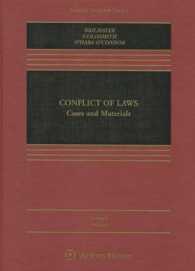- ホーム
- > 洋書
- > 英文書
- > Science / Mathematics
Full Description
For undergraduate courses in nanoelectronics. This is the first actual nanoelectronics textbook for undergraduate engineering and applied sciences students. It provides an introduction to nanoelectronics, as well as a self-contained overview of the necessary physical concepts - taking a fairly gentle but serious approach to a field that will be extremely important in the near future.
Contents
PREFACE xiACKNOWLEDGMENTS xiiiPHOTO CREDITS xv1.1 The "Top-Down" Approach 61.1.1 Lithography, 81.2 The "Bottom-Up" Approach 121.3 Why Nanoelectronics? 121.4 Nanotechnology Potential 141.5 Main Points 151.6 Problems 162 CLASSICAL PARTICLES, CLASSICALWAVES, AND QUANTUM PARTICLES 172.1 Comparison of Classical and Quantum Systems 182.2 Origins of Quantum Mechanics 202.3 Light As a Wave, Light As a Particle 212.3.1 Light As a Particle, or Perhaps a Wave - The Early Years, 212.3.2 A Little Later - Light as a Wave, 212.3.3 Finally, Light As a Quantum Particle, 262.4 Electrons As Particles, Electrons As Waves 292.4.1 Electrons As Particles - The Early Years, 292.4.2 A Little Later - Electrons (and Everything Else) As Quantum Particles, 292.4.3 Further Development of Quantum Mechanics, 322.5 Wavepackets and Uncertainty 342.6 Main Points 412.7 Problems 423.1 General Postulates of Quantum Mechanics 463.1.1 Operators, 483.1.2 Eigenvalues and Eigenfunctions, 493.1.3 Hermitian Operators, 503.1.4 Operators for Quantum Mechanics, 533.1.5 Measurement Probability, 573.2 Time-Independent Schrodinger's Equation 633.2.1 Boundary Conditions on the Wavefunction, 663.3 Analogies Between Quantum Mechanics and Classical Electromagnetics 713.4 Probabilistic Current Density 723.5 Multiple Particle Systems 763.6 Spin and Angular Momentum 803.7 Main Points 823.8 Problems 834 FREE AND CONFINED ELECTRONS 874.1 Free Electrons 874.1.1 One-Dimensional Space, 884.1.2 Three-Dimensional Space, 914.2 The Free Electron Gas Theory of Metals 924.3 Electrons Confined to a Bounded Region of Space, and Quantum Numbers 934.3.1 One-Dimensional Space, 934.3.2 Three-Dimensional Space, 994.3.3 Periodic Boundary Conditions, 1004.4 Fermi Level and Chemical Potential 1014.5 Partially Confined Electrons - Finite Potential Wells 1034.5.1 Finite Rectangular Well, 1044.5.2 Parabolic Well - Harmonic Oscillator, 1114.5.3 Triangular Well, 1124.6 Electrons Confined to Atoms - The Hydrogen Atom and the Periodic Table 4.6 1134.6.1 The Hydrogen Atom and Quantum Numbers, 1144.6.2 Beyond Hydrogen - Multiple Electron Atoms and the Periodic Table , 1184.7 Quantum Dots, Wires, and Wells 1204.7.1 Quantum Wells, 1244.7.2 Quantum Wires, 1264.7.3 Quantum Dots, 1284.8 Main Points 1304.9 Problems 1305.1 Crystalline Materials 1355.2 Electrons in a Periodic Potential 1395.3 Kronig-Penney Model of Band Structure 1405.3.1 Effective Mass, 1445.4 Band Theory of Solids 1535.4.1 Doping in Semiconductors, 1575.4.2 Interacting Systems Model, 1605.4.3 The Effect of an Electric Field on Energy Bands, 1635.4.4 Bandstructures of Some Semiconductors, 1635.4.5 Electronic Band Transitions - Interaction of Electromagnetic Energy and Materials, 1655.5 Graphene and Carbon Nanotubes 1735.5.1 Graphene, 1735.5.2 Carbon Nanotubes, 1755.6 Main Points 1805.7 Problems 1806.1 Tunneling Through a Potential Barrier 1886.2 Potential Energy Profiles for Material Interfaces 1946.2.1 Metal-Insulator, Metal-Semiconductor, and Metal-Insulator-Metal Junctions, 1946.3 Applications of Tunneling 1996.3.1 Field Emission, 1996.3.2 Gate-Oxide Tunneling and Hot Electron Effects in MOSFETs, 2026.3.3 Scanning Tunneling Microscope, 2066.3.4 Double Barrier Tunneling and the Resonant Tunneling Diode, 2106.4 Main Points 2146.5 Problems 2147 COULOMB BLOCKADE AND THE SINGLE-ELECTRON TRANSISTOR 2167.1 Coulomb Blockade 2167.1.1 Coulomb Blockade in a Nanocapacitor, 2187.1.2 Tunnel Junctions, 2237.1.3 Tunnel Junction Excited by a Current Source, 2267.1.4 Coulomb Blockade in a Quantum Dot Circuit, 2307.2 The Single-Electron Transistor 2407.2.1 Single-Electron Transistor Logic, 2487.3 Other SET and FET Structures 2507.3.1 Carbon Nanotube Transistors (FETs and SETs), 2507.3.2 Semiconductor Nanowire FETs and SETs, 2557.3.3 Molecular SETs and Molecular Electronics, 2577.4 Main Points 2617.5 Problems 262PART III MANY ELECTRON PHENOMENA 2658.1 Density of States 2688.1.1 Density of States in Lower Dimensions, 2708.1.2 Density of States in a Semiconductor, 2738.2 Classical and Quantum Statistics 2738.2.1 Carrier Concentration in Materials, 2768.2.2 The Importance of the Fermi Electrons, 2808.2.3 Equilibrium Carrier Concentration and the Fermi Level in Semiconductors, 2808.3 Main Points 2838.4 Problems 2839.1 Semiconductor Heterostructures and Quantum Wells 2889.1.1 Confinement Models and Two-Dimensional Electron Gas, 2929.1.2 Energy Band Transitions in Quantum Wells, 2959.2 Quantum Wires and Nanowires 3019.3 Quantum Dots and Nanoparticles 3059.3.1 Applications of Semiconducting Quantum Dots, 3069.3.2 Plasmon Resonance and Metallic Nanoparticles, 3129.3.3 Functionalized Metallic Nanoparticles, 3139.4 Fabrication Techniques for Nanostructures 3159.4.1 Lithography, 3159.4.2 Nanoimprint Lithography, 3179.4.3 Split-Gate Technology, 3189.4.4 Self-Assembly, 3189.5 Main Points 3229.6 Problems 32210 NANOWIRES, BALLISTIC TRANSPORT, AND SPIN TRANSPORT 32610.1 Classical and Semiclassical Transport 32710.1.1 Classical Theory of Conduction-Free Electron Gas Model, 32710.1.2 Semiclassical Theory of Electrical Conduction - Fermi Gas Model , 33010.1.3 Classical Resistance and Conductance, 33310.1.4 Conductivity of Metallic Nanowires - The Influence of Wire Radius, 33510.2 Ballistic Transport 33710.2.1 Electron Collisions and Length Scales, 33810.2.2 Ballistic Transport Model, 34010.2.3 Quantum Resistance and Conductance, 34110.2.4 Origin of the Quantum Resistance, 34810.3 Carbon Nanotubes and Nanowires 34910.3.1 The Effect of Nanoscale Wire Radius on Wave Velocity and Loss , 35310.4 Transport of Spin and Spintronics 35610.4.1 The Transport of Spin, 35610.4.2 Spintronic Devices and Applications, 36110.5 Main Points 36210.6 Problems 362APPENDIX A SYMBOLS AND ACRONYMS 365APPENDIX C CONVENTIONAL MOSFETS 372Problems Chapter 2: Classical Particles, Classical Waves, and Quantum Particles, 376Problems Chapter 3: Quantum Mechanics of Electrons, 377Problems Chapter 4: Free and Confined Electrons, 378Problems Chapter 5: Electrons Subject to a Periodic Potential - Band Theory of Solids, 379Problems Chapter 6: Tunnel Junctions and Applications of Tunneling, 380Problems Chapter 7: Coulomb Blockade and the Single-Electron Transistor, 381Problems Chapter 8: Particle Statistics and Density of States, 381Problems Chapter 9: Models of Semiconductor Quantum Wells, Quantum Wires,and Quantum Dots, 382Problems Chapter 10: Nanowires, Ballistic Transport, and Spin Transport, 383BIBLIOGRAPHY 383INDEX 393






